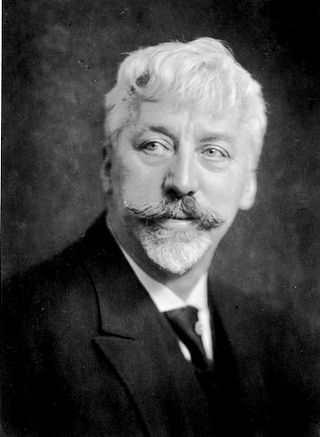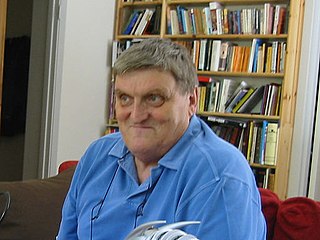Related Research Articles

Johan Falkberget, born Johan Petter Lillebakken, was a Norwegian author. He was nominated for the Nobel Prize in Literature.
Kjell Heggelund was a Norwegian literary researcher, lecturer, editor, manager, poet, translator and literary critic.
Events in the year 1914 in Norway.
Anders Krogvig was a Norwegian librarian, writer, literary consultant and critic.

Edvard Freydar Beyer was a Norwegian literary historian, literary critic, and professor at the University of Oslo from 1958 to 1990.

Nini Roll Anker was a Norwegian novelist and playwright. Her books often concerned the lives of women within different social classes as well as the women's rights movement and the rights of the working class.

Erik Vullum was a Norwegian journalist, writer and politician for the Liberal Party.

Hans Wiers-Jenssen was a Norwegian novelist, playwright, stage producer and theatre historian. Wiers-Jenssen was employed at the theatres Christiania Theatre, Nationaltheatret and Den Nationale Scene.

Helge Krog was a Norwegian journalist, essayist, theatre and literary critic, translator and playwright.

Maren Cathrine Sars was a Norwegian socialite.

Philip Newth is an Anglo-Norwegian author of children's literature. He has written more than fifty books, including books for deaf and blind children.
Karin Sveen is a Norwegian poet, novelist and essayist.
Nyt Tidsskrift is a former Norwegian literary, cultural and political periodical issued from 1882 to 1887, and with a second series from 1892 to 1895. The periodical had contributions from several of the leading intellectuals of the time, including later Nobel Literature Prize laureate Bjørnstjerne Bjørnson, later Nobel Peace Prize laureate Fredrik Bajer, the writers Alexander L. Kielland, Jonas Lie, Arne Garborg and Hans Aanrud, proponents for women's rights Camilla Collett, Gina Krog and Hagbard Emanuel Berner, and painter Erik Werenskiold.
Nidaros was a Norwegian newspaper, published in Trondheim in Sør-Trøndelag.
Ragnhild Magerøy was a Norwegian novelist, essayist and poet. She is principally known as a historical novelist.
Bør Børson jr. is a satirical novel from the boom period during World War I, written by Norwegian writer Johan Falkberget. It was first published as a feuilleton in the satirical magazine Hvepsen in 1917, then again printed as a feuilleton in the newspaper Nidaros, and issued as a book in 1920. The story was a great success, and has later been adapted into two films, a comedy, a musical, and a comic series.

Barbra Mathilde Ring was a Norwegian novelist, short story writer, children's writer, biographer, memoirist, literary critic and theatre critic. She made her literary début in 1904 with the girl's novel Babbens Dagbog. Her children's books about "Peik" and other characters achieved great popularity. Her first novel for adults was Jomfruen, published in 1914.
Peder Elias Bjørnson (1798–1871) was a Norwegian priest, best known for being the father of Bjørnstjerne Bjørnson.

Heim is a former municipality in the old Sør-Trøndelag county in Norway. The 271-square-kilometre (105 sq mi) municipality existed from 1911 until its dissolution in 1964. The municipality encompassed the northern part of what is now Heim and Orkland municipalities and the southeastern part of Hitra municipality in Trøndelag county. The administrative centre was the village of Heim where Heim Church is located.
Aasta Falkberget was a Norwegian writer and painter.
References
- 1 2 Skei, Hans H.; Moi, Morten; Tørset, Espen (2021). "Johan Falkberget". Store norske leksikon (in Norwegian). Oslo: Kunnskapsforlaget. Retrieved October 23, 2021.
- 1 2 Berg, Arngeir (2009). "Johan Falkberget". Norsk biografisk leksikon (in Norwegian). Oslo: Kunnskapsforlaget. Retrieved October 23, 2021.
- ↑ Sjåvik, Jan (2009). The A to Z of Scandinavian Literature and Theater. Lanham, MD: Scarecrow Press. p. 66.
- ↑ Beyer, Edvard; Holm-Olsen, Ludvig; Heggelund, Kjell; Hauge, Ingard; Bø, Olav; Nettum, Rolf Nyboe; Amdam, Per; Birkeland, Bjarte; Egeland, Kjølv; Ørjasæter, Tordis; Dahl, Willy (1975). Norges litteratur historie. Oslo: Cappelen. p. 458.
Lidelsen omskaper, lutrer og frigjør Benjamin og Gunhild – som Ol-Kanelesa – så de fremstår som hele personligheter, identiske med sine beste egenskaper .... Slik blir også Benjamin en representant for mennesker i dets storhet og svakhet.